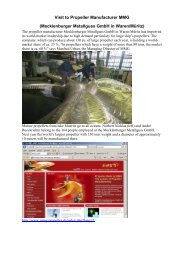Ernst Barlach Museum Güstrow
Ernst Barlach Museum Güstrow
Ernst Barlach Museum Güstrow
You also want an ePaper? Increase the reach of your titles
YUMPU automatically turns print PDFs into web optimized ePapers that Google loves.
<strong>Ernst</strong> <strong>Barlach</strong> <strong>Museum</strong> <strong>Güstrow</strong><br />
(http://www.ernst-barlach-stiftung.de/index.php?id=161 )<br />
The northern German sculptor and graphic artist <strong>Ernst</strong> <strong>Barlach</strong> began his professional education in<br />
Hamburg. In 1888 Berlach attended a vocational school. In 1891 the artist attended the Dresden<br />
'Akademie', where he continued to study sculpture and became Robert Diez's master student. During<br />
two study trips to Paris in 1895 and 1897 <strong>Barlach</strong>'s well-founded academic training was reinforced. His<br />
artistic work was influenced greatly by a trip to Russia in 1906. The powerful and folk-like design of<br />
<strong>Barlach</strong>'s sculptures after this time reflect the impressions of rugged farm-life and Russian folk art.<br />
During these years <strong>Barlach</strong> also produced graphic illustration cycles for his own plays. In 1910 <strong>Ernst</strong><br />
<strong>Barlach</strong> settled in <strong>Güstrow</strong> (Mecklenburg), Germany. In 1917 <strong>Barlach</strong> had his first exhibition at<br />
Paul Cassirer's in Berlin. In 1919 the sculptor was admitted to the 'Preußische Akademie der Künste'<br />
in Berlin as a full member. During the following years <strong>Barlach</strong> produced numerous wood carvings,<br />
including one on Goethe's 'Walpurgisnacht'. In 1928 <strong>Barlach</strong> published his autobiography entitled 'Ein<br />
selbsterzähltes Leben' ('A Selftold Life'). In 1930 a comprehensive exhibition of <strong>Barlach</strong>'s sculptures<br />
and graphic works took place at the 'Preussische Akademie der Künste' in Berlin. In 1933 the artist<br />
received the order 'Pour le mérité'. In 1935, commission by Hermann F. Reemtsma, <strong>Barlach</strong> designed<br />
the 'Fries der Lauschenden' and a tombstone for Theodor Däubler. During the years that followed, the<br />
sculptor was ostracized by the Nazis. In 1936 <strong>Barlach</strong>'s works were systematically removed from<br />
museums, churches, and public spaces. Today, <strong>Ernst</strong> <strong>Barlach</strong> is known as one of the most<br />
important sculptors of Classical Modernism. Excellent examples of his expressionist wood and<br />
bronze sculptures can now be seen at the <strong>Güstrow</strong> Cathedral, the Elisabeth Church in Marburg<br />
and the Berlin National Gallery. <strong>Ernst</strong> <strong>Barlach</strong>'s home and studio in <strong>Güstrow</strong> is now open to the<br />
public as a museum (http://www.barlach-ernst.de/e/index.shtml )<br />
With a volume of over 1.100 items the <strong>Ernst</strong> <strong>Barlach</strong> Stiftung <strong>Güstrow</strong> houses the largest cohesive inventory of<br />
drawings and additionally sculptures and prints of that famous German artist <strong>Ernst</strong> <strong>Barlach</strong> (1870-1938). The<br />
artist`s sketch book and notebooks of wich only few are known also have to be examined as part of this large<br />
assortment of drawings. The <strong>Ernst</strong> <strong>Barlach</strong> Stiftung <strong>Güstrow</strong> possesses 111 samples of such books.<br />
Atelierhaus
Research project: Drawings by <strong>Ernst</strong> <strong>Barlach</strong><br />
(1870-1938, Germany)<br />
In the past years, we have completed oeuvre catalogues on the prints and sculptures of <strong>Ernst</strong> <strong>Barlach</strong> (1870-<br />
1938). The third part of this research programme is dedicated to <strong>Barlach</strong>`s drawings. This new oeuvre catalogue,<br />
now in preparation, is part of an ambitious programme to re-evaluate the artist`s entire esatate. The <strong>Ernst</strong> von<br />
Siemens Kulturstiftung is financing this long-term research programme.<br />
With a volume of over 1.100 items the <strong>Ernst</strong> <strong>Barlach</strong> Stiftung <strong>Güstrow</strong> houses the largest cohesive inventory of<br />
drawings. The <strong>Ernst</strong> <strong>Barlach</strong> Haus Hamburg, Stiftung Hermann F. Reemstma owns further 400 drafts, sketches<br />
and autonomous depictions. In addition, there are approximatly 1.000 works in public and private collections.<br />
The artist`s sketch book and notebooks of wich only few are known also have to be examined as part of this<br />
large assortment of drawings. The <strong>Ernst</strong> <strong>Barlach</strong> Stiftung <strong>Güstrow</strong> possesses 111 samples of such books.<br />
A major task of this projekt is to verify the whereabouts of the works and check their actual stat; not in every<br />
case, do the records mentioned in the oeuvre catalogue by Friedrich Schult from 1971 still apply and many of the<br />
works have not been catalogued yet. The <strong>Ernst</strong> <strong>Barlach</strong> Stiftung <strong>Güstrow</strong> would, therefore, like to ask interested<br />
people and collectors for details which may lead to the clarification of these questions.<br />
Mann mit Stock, sich zu einem Hund neigend, 1908; Feder über Bleistift<br />
Versuchung, 1915/16; Kohle<br />
Junge Frau mit angehobener Schürze, 1915; Kohle<br />
Abwehrender, 1918; Kohle





